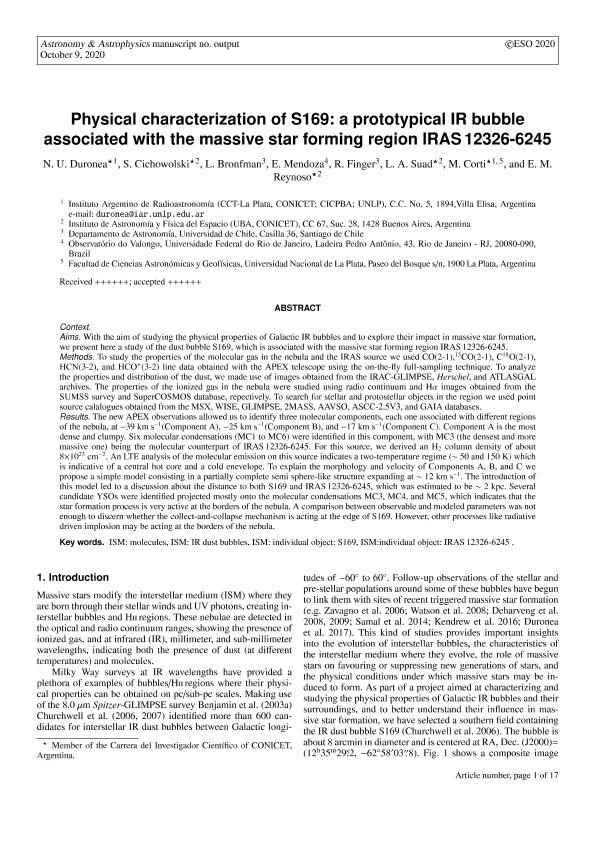Mostrar el registro sencillo del ítem
dc.contributor.author
Duronea, Nicolas Urbano

dc.contributor.author
Cichowolski, Silvina

dc.contributor.author
Bronfman, L.
dc.contributor.author
Mendoza, E.
dc.contributor.author
Finger, R.
dc.contributor.author
Suad, Laura Andrea

dc.contributor.author
Corti, Mariela Alejandra

dc.contributor.author
Reynoso, Estela Marta

dc.date.available
2023-01-03T12:18:50Z
dc.date.issued
2021-02-15
dc.identifier.citation
Duronea, Nicolas Urbano; Cichowolski, Silvina; Bronfman, L.; Mendoza, E.; Finger, R.; et al.; Physical characterization of S169: a prototypical IR bubble associated with the massive star-forming region IRAS 12326-6245; EDP Sciences; Astronomy and Astrophysics; 646; 15-2-2021; 1-18
dc.identifier.issn
0004-6361
dc.identifier.uri
http://hdl.handle.net/11336/183101
dc.description.abstract
Aims. With the aim of studying the physical properties of Galactic IR bubbles and to explore their impact in massive star formation, we present a study of the IR bubble S169, associated with the massive star forming region IRAS 12326-6245. Methods. We used CO(2-1),13CO(2-1), C18O(2-1), HCN(3-2), and HCO+ (3-2) line data obtained with the APEX telescope using the on-the-fly full sampling technique to study the properties of the molecular gas in the nebula and the IRAS source . To analyze the properties and distribution of the dust, we made use of images obtained from the IRAC-GLIMPSE, Herschel, and ATLASGAL archives. The properties of the ionized gas in the nebula were studied using radio continuum and Hα images obtained from the SUMSS survey and SuperCOSMOS database, respectively. In our search for stellar and protostellar objects in the region, we used point source calalogs obtained from the MSX, WISE, GLIMPSE, 2MASS, AAVSO, ASCC-2.5V3, and GAIA databases. Results. The new APEX observations allowed us to identify three molecular components, each one associated with different regions of the nebula, namely: at −39 km s−1 (component A), −25 km s−1 (component B), and −17 km s−1 (component C). Component A is shown to be the most dense and clumpy. Six molecular condensations (MC1 to MC6) were identified in this component, with MC3 (the densest and more massive one) being the molecular counterpart of IRAS 12326-6245. For this source, we estimated an H2 column density up to 8×1023 cm−2 . An LTE analysis of the high density tracer lines HCO+ (3-2) and HCN(3-2) on this source, assuming 50 and 150 K, respectively, indicates column densities of N(HCO+ ) = (5.2 ± 0.1) × 1013 cm−2 and N(HCN) = (1.9 ± 0.5) × 1014 cm−2 . To explain the morphology and velocity of components A, B, and C , we propose a simple model consisting of a partially complete semisphere-like structure expanding at ∼ 12 km s−1 . The introduction of this model has led to a discussion about the distance to both S169 and IRAS 12326-6245, which was estimated to be ∼ 2 kpc. Several candidate YSOs were identified, projected mostly onto the molecular condensations MC3, MC4, and MC5, which indicates that the star-formation process is very active at the borders of the nebula. A comparison between observable and modeled parameters was not enough to discern whether the collect-and-collapse mechanism is acting at the edge of S169. However, other processes such as radiative-driven implosion or even a combination of both mechanisms, namely, collect-and-collapse and radiative-driven implosion, could be acting simultaneously in the region.
dc.format
application/pdf
dc.language.iso
eng
dc.publisher
EDP Sciences

dc.rights
info:eu-repo/semantics/openAccess
dc.rights.uri
https://creativecommons.org/licenses/by-nc-sa/2.5/ar/
dc.subject
HII REGIONS
dc.subject
ISM: BUBBLES
dc.subject
ISM: KINEMATICS AND DYNAMICS
dc.subject
ISM: MOLECULES
dc.subject.classification
Otras Ciencias Naturales y Exactas

dc.subject.classification
Otras Ciencias Naturales y Exactas

dc.subject.classification
CIENCIAS NATURALES Y EXACTAS

dc.title
Physical characterization of S169: a prototypical IR bubble associated with the massive star-forming region IRAS 12326-6245
dc.type
info:eu-repo/semantics/article
dc.type
info:ar-repo/semantics/artículo
dc.type
info:eu-repo/semantics/publishedVersion
dc.date.updated
2021-11-04T13:17:56Z
dc.identifier.eissn
1432-0746
dc.journal.volume
646
dc.journal.pagination
1-18
dc.journal.pais
Francia

dc.description.fil
Fil: Duronea, Nicolas Urbano. Consejo Nacional de Investigaciones Científicas y Técnicas. Centro Científico Tecnológico Conicet - La Plata. Instituto de Astrofísica La Plata. Universidad Nacional de La Plata. Facultad de Ciencias Astronómicas y Geofísicas. Instituto de Astrofísica La Plata; Argentina
dc.description.fil
Fil: Cichowolski, Silvina. Consejo Nacional de Investigaciones Científicas y Técnicas. Oficina de Coordinación Administrativa Ciudad Universitaria. Instituto de Astronomía y Física del Espacio. - Universidad de Buenos Aires. Facultad de Ciencias Exactas y Naturales. Instituto de Astronomía y Física del Espacio; Argentina
dc.description.fil
Fil: Bronfman, L.. Universidad de Chile; Chile
dc.description.fil
Fil: Mendoza, E.. Universidade Federal do Rio de Janeiro; Brasil
dc.description.fil
Fil: Finger, R.. Universidad de Chile; Chile
dc.description.fil
Fil: Suad, Laura Andrea. Consejo Nacional de Investigaciones Científicas y Técnicas. Oficina de Coordinación Administrativa Ciudad Universitaria. Instituto de Astronomía y Física del Espacio. - Universidad de Buenos Aires. Facultad de Ciencias Exactas y Naturales. Instituto de Astronomía y Física del Espacio; Argentina
dc.description.fil
Fil: Corti, Mariela Alejandra. Universidad Nacional de La Plata. Facultad de Ciencias Astronómicas y Geofísicas; Argentina. Provincia de Buenos Aires. Gobernación. Comisión de Investigaciones Científicas. Instituto Argentino de Radioastronomía. Consejo Nacional de Investigaciones Científicas y Técnicas. Centro Científico Tecnológico Conicet - La Plata. Instituto Argentino de Radioastronomía; Argentina
dc.description.fil
Fil: Reynoso, Estela Marta. Consejo Nacional de Investigaciónes Científicas y Técnicas. Oficina de Coordinación Administrativa Ciudad Universitaria. Instituto de Astronomía y Física del Espacio. - Universidad de Buenos Aires. Facultad de Ciencias Exactas y Naturales. Instituto de Astronomía y Física del Espacio; Argentina
dc.journal.title
Astronomy and Astrophysics

dc.relation.alternativeid
info:eu-repo/semantics/altIdentifier/url/https://www.aanda.org/articles/aa/full_html/2021/02/aa39074-20/aa39074-20.html
dc.relation.alternativeid
info:eu-repo/semantics/altIdentifier/doi/https://doi.org/10.1051/0004-6361/202039074
dc.relation.alternativeid
info:eu-repo/semantics/altIdentifier/url/https://arxiv.org/abs/2012.06328
Archivos asociados
